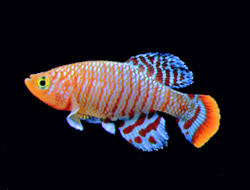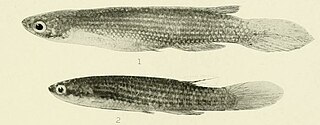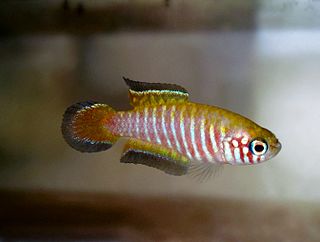
Cyprinodontiformes is an order of ray-finned fish, comprising mostly small, freshwater fish. Many popular aquarium fish, such as killifish and live-bearers, are included. They are closely related to the Atheriniformes and are occasionally included with them. A colloquial term for the order as a whole is toothcarps, though they are not actually close relatives of the true carps – the latter belong to the superorder Ostariophysi, while the toothcarps are Acanthopterygii.

Aplocheilidae, the Asian killifishes or Asian rivulines, is a family of fish in the order Cyprinodontiformes found in Asia. Some authorities use this family-group name, which is well-established, for a single lumped aplocheiloid family as it gives the nomenclature stability over time and avoids the impact of a new name at family rank for a popular aquarium fish group. Following this proposal, Aplocheilidae would include three subfamilies: Aplocheilinae for the species from Asia, Madagascar and the Seychelles; Cynolebiinae for the species from the Americas; and Nothobranchiinae for the species from the African mainland. However, the 5th edition of Fishes of the World still classifies these as separate families, and at least one 2008 study suggests that even the narrow Aplocheilidae may not be monophyletic, with Aplocheilus itself possibly being basal to all other Cyprinodontiforms and thus only distantly related to the younger Pachypanchax.
Leptolebias marmoratus, the marbled pearlfish, annual tropical killifish or ginger pearlfish, is a species of killifish in the family Rivulidae. This threatened species is found in temporary channels within dense Atlantic rainforest, in the floodplains of rivers draining into the Baía de Guanabara, near the city of Rio de Janeiro in southeastern Brazil. It reaches up to 3 cm (1.2 in) in total length.

Leptolebias is a ray-finned fish genus of the killifish family Rivulidae. Like many of their relatives, they are rather ambiguously known as "pearlfish".

Leptolebias opalescens, also known as the opal pearlfish, annual tropical killifish or opalescent pearlfish, is a species of killifish in the family Aplocheilidae endemic to Brazil. This species was described as Cynolebias opalescens by George S. Myers in 1942 with the type locality given as the base of the Serra do Petrópolis, near Imbarié in the municipality of Duque de Caxias, Rio de Janeiro.
Leptolebias splendens, also known as the splendid pearlfish or annual tropical killifish, is a species of killifish in the family Rivulidae endemic to Brazil, in the vicinity of Rio de Janeiro. This species was described as Cynolebias splendens in 1942 by George S. Myers with the type locality given as water holes or ponds along the foot of the Serra de Petropolis in Rio de Janeiro State. Deforestation and urbanisation led to the species disappearance from the area of its type locality and it was thought to be extinct but it was rediscovered 5 kilometres from the type locality some 70 years after the last known previous record.

Nothobranchiidae are a family of bony fishes containing roughly 300 species, also known as African rivulines. They are small killifish, usually measuring about 5 centimetres (2.0 in). They are limited to Africa, living in fresh water but being also somewhat salt-tolerant. They are also found in muddy or brackish water. Some species are kept as aquarium pets. They have frilly fins and many are brightly colored. They were formerly included in the family Aplocheilidae ; a return to that broader family has recently been suggested.
Austrofundulus is a genus of killifish in the family Rivulidae native to northern Colombia, northern Venezuela and southwestern Guyana. They are annual killifish where adults generally have a short life in temporary ponds or swamps and the eggs experience a period of drought, only hatching when again covered by water.

Austrolebias is a genus of killifish in the family Rivulidae. These annual killifish live in temporary pools, swamps and streams in the Río de la Plata, Patos–Mirim and Mamoré basins in South America.

Melanorivulus is a genus of South American freshwater fish in the family Rivulidae. Most species are endemic to the Río de la Plata, eastern Amazon, Tocantins–Araguaia and São Francisco basins in Brazil, but a few members of this genus range west into Bolivia, south into Paraguay and Argentina, and east to Parnaíba and Sergipe in northeastern Brazil. Only M. schuncki occurs north of the Amazon River. They inhabit shallow waters, generally 5–30 cm (2–12 in) deep, at the margins of streams in open or fairly open habitats like the Cerrado or Cerrado–Amazon transition. Many have tiny ranges and are seriously threatened.

Anablepsoides is a genus of killifish in the family Rivulidae native to tropical South America and the Lesser Antilles. The majority are from the Amazon and Orinoco basins, as well as freshwater systems in the Guiana Shield, but a few species are from northern Venezuela, northeastern Brazil and the Lesser Antilles. Although largely restricted to lowlands, a few species occur in the lower East Andean foothills. They are mostly found in shallow fresh water swamps, streams, edges of rivers, ponds and pools, but a few may occur in brackish estuaries. They are able to jump over land and breathe air for short periods, allowing them to access isolated waters inhabited by few or no other fish. Several Anablepsoides species have small distributions and some are seriously threatened by habitat loss; the entire known range of A. xinguensis is in the area flooded by the Belo Monte Dam.

Laimosemion is a genus of fish in the family Rivulidae from the Amazon basin and basins in the Guiana Shield in tropical South America. They mostly inhabit small streams, creeks, swamps and pools in lowlands, but locally occur to an altitude of 1,300 m (4,300 ft).
Notholebias is a genus of fish in the family Rivulidae. These threatened annual killifish are endemic temporary waters, like ponds, in the Atlantic Forest in Rio de Janeiro state, Brazil.
Pterolebias is a genus of killifish from the family Rivulidae which are native to temporary swamps and ponds in South America. It includes two groups, which sometimes are regarded as separate genera: Pterolebias from the southern Amazon and Paraguay river basins, and Gnatholebias from the Orinoco river basin.
Rachovia is a genus of killifish from the family Rivulidae the species of which are endemic to the Orinoco, Maracaibo and Magdalena basins in Colombia and Venezuela, where they live in small temporary waters like ponds. They are small annual killifish that reach up to 6 cm (2.4 in) in total length. The name of this genus honours the German aquarist Arthur Rachow (1884–1960) who sent fish specimens to George S. Myers.

Simpsonichthys is a genus of killifish from the family Rivulidae the species of which are endemic to temporary freshwater habitats like ponds in the upper Paraná, upper Araguaia, upper Jequitinhonha and São Francisco basins on the central Brazilian Plateau. They are small annual killifish that reach up to 5.5 cm (2.2 in) in standard length.
Xenurolebias is a genus of fish in the family Rivulidae. These annual killifish are endemic to temporary pools in the Atlantic forest near the coast in southeast Bahia and Espírito Santo, Brazil.

Simpsonichthys constanciae is a species of killifish from the family Rivulidae that is endemic to Brazil. It is restricted to temporary freshwater habitats in the São João basin in Rio de Janeiro, while all other species in the genus are from Bahia. It is a small killifish that is up to 6 cm (2.4 in) in total length.

Leptopanchax is a genus of small fish, up to 5 cm (2.0 in) long, in the family Rivulidae. They are found in southeastern Brazil from Paraná to Rio de Janeiro. Depending on the exact species, they inhabit small seasonal channels in the Atlantic rainforest or temporary pools in open habitats. Several Leptopanchax species are very rare and L. sanguineus is possibly extinct.

Aplocheiloidei is a suborder of the order Cyprinodontiformes consisting of three families which are commonly known as killifishes.













